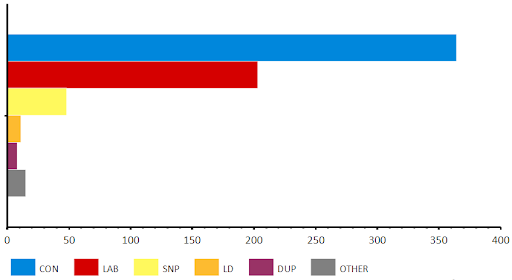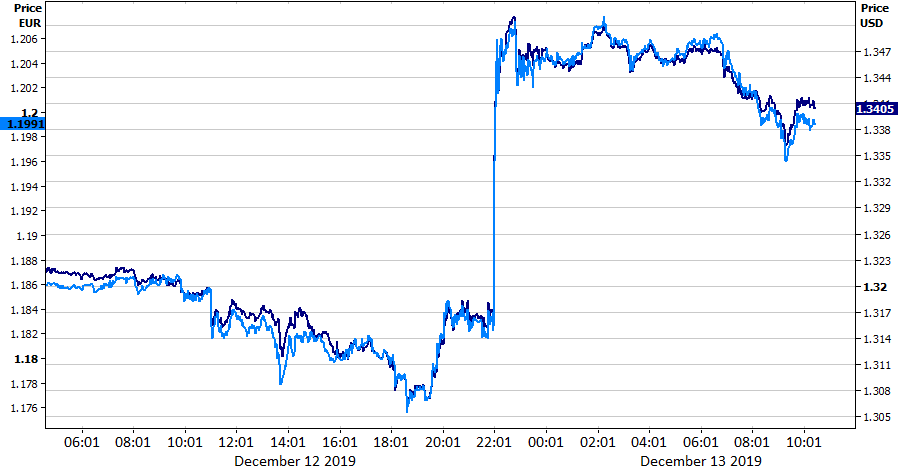Pound soars after Conservatives secure massive majority victory
- Go back to blog home
- Latest
Sterling leapt to its strongest position versus the US dollar since May 2018 late on Thursday evening after yet another extraordinary night of political drama in the UK.
The exit poll, which had very closely predicted the number of seats that both of the two main parties would obtain back in 2017, suggested that the Tories were on course for a massive 86 seat majority. This was far greater than almost everyone in the market had anticipated, exceeding even the most bullish of projections. For context, YouGov’s MRP (Multilevel Regression and Post-stratification) model, the most comprehensive of its kind in the UK, had pointed to just a 28 seat majority as recently as Tuesday. Some of the more recent opinion polls had also shown a modest 6% advantage for the Tories. In reality, this lead was in excess of 11%.
As the results began to filter through during the early hours it was pretty clear that it was going to be a great night for Johnson’s Party. Traditional Labour strongholds in the likes of Blyth Valley, Darlington, Leigh and Wexham, industrial communities that had been held by the party uninterrupted for decades, all fell by the wayside. This is made all the more remarkable given that many of these areas are ex-mining districts that saw massive job losses under Thatcher’s Tory government in the 1980s. While Corbyn himself comfortably held his seat in Islington North, there were a number of major casualties, most notably Lib Dem leader Jo Swinson.
As they were at the 2017 election, market research company Ipsos MORI proved remarkably accurate with their exit poll. While the actual Tory majority was slightly less in reality, they still obtained a massive 364* seats, a comfortable majority of 78*. Not only was this the largest House of Commons majority since 2001 and the biggest Tory majority since 1987, but also the worst performance of the Labour Party since 1935.
Figure 1: UK Election Results [December 2019]
Sterling immediately rallied by over two-and-a-half percent versus the dollar and by around 1.8% against the euro following the release of the initial exit poll. That was pretty much that as far as major gyrations in the currency were concerned. The sheer magnitude of victory that the exit poll suggested ensured that there was no way back for Labour, with the actual results merely confirming what the poll had indicated. We had said prior to the election that we thought sterling would rally to the 1.34 level versus the US dollar and the 1.20 level against the euro in the immediate aftermath of the vote under a Tory majority victory. At the time of writing with just one seat yet to be announced, GBP/USD is trading just above the 1.34 mark, with GBP/EUR bang on 1.20.
Figure 2: GBP/USD &GBP/EUR (12/12 – 13/12)
, The main rationale behind the sharp upward move in the UK currency is, of course, the fact that a Tory majority removes the threat of a ‘no deal’ Brexit, long seen as the worst-case scenario for both the UK economy and the pound. It also avoids the threat of a hung parliament that investors feared may have led to another extension to the Article 50 deadline and prolonged renegotiations with the European Union deep into 2020.
What happens next?
Labour leader Jeremy Corbyn has not yet officially resigned, although this is merely a matter of time. Liberal Democrats leader Jo Swinson has already announced she will be stepping down following their very underwhelming showing.
With a big parliamentary majority secured, Johnson will now move full speed ahead to force his Brexit Withdrawal Agreement Bill through the House of Commons as soon as possible. The vote looks more likely than not to take place before Christmas, potentially during an extraordinary session on Saturday 21st December. This is all but certain to pass without a hitch. The bill will then go through the House of Lords, possibly at some point between Christmas and the New Year.
The passing of the bill will all but ensure that the UK leaves the European Union by the end of January deadline. We think that this alleviation of the ‘no deal’ uncertainty should continue to provide good support for sterling in the next few months. Attention will then quickly turn to the actual Brexit negotiations, primarily whether or not the Prime Minister will target a slightly softer Brexit that could alleviate the potential impact on the UK economy.
The UK will enter into a transition period that will run from the end of January to 31st December 2020. While the Tories have stated in their manifesto that they will not ask to extend the transition period, many political analysts are pretty sceptical as to whether this will provide enough time for negotiations to take place. The end of June deadline to ask the EU for an extension will come round quick. Should it become clear that a cliff-edge exit is back on the table at the end of the year then we may see a retracement in the pound in the second half of the year, although this is not our or indeed the market’s base case.
Despite this aforementioned risk, we remain very optimistic regarding the prospects for the pound. We think that the removal of the ‘no deal’ threat should begin to filter its way through to an improvement in sentiment towards sterling that should, in our view, lift it back towards the 1.40 level later in 2020.



